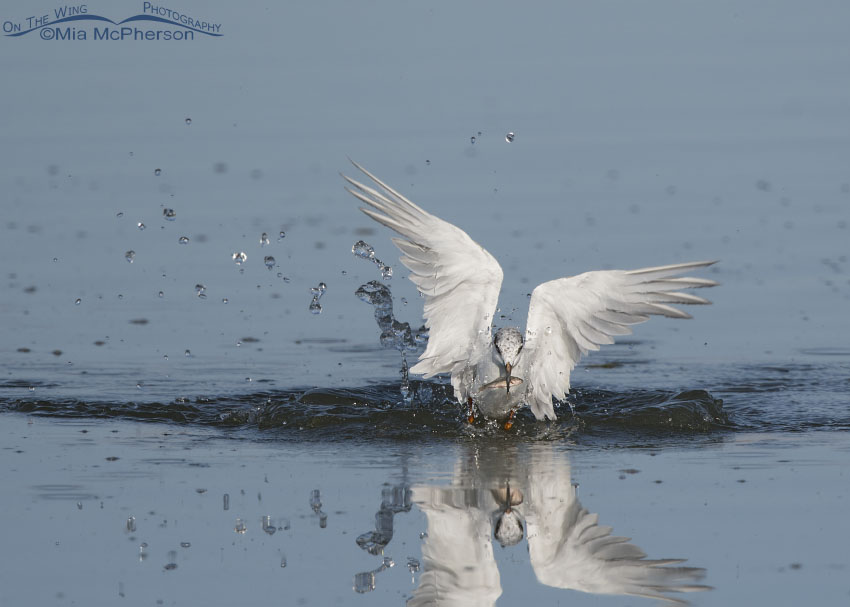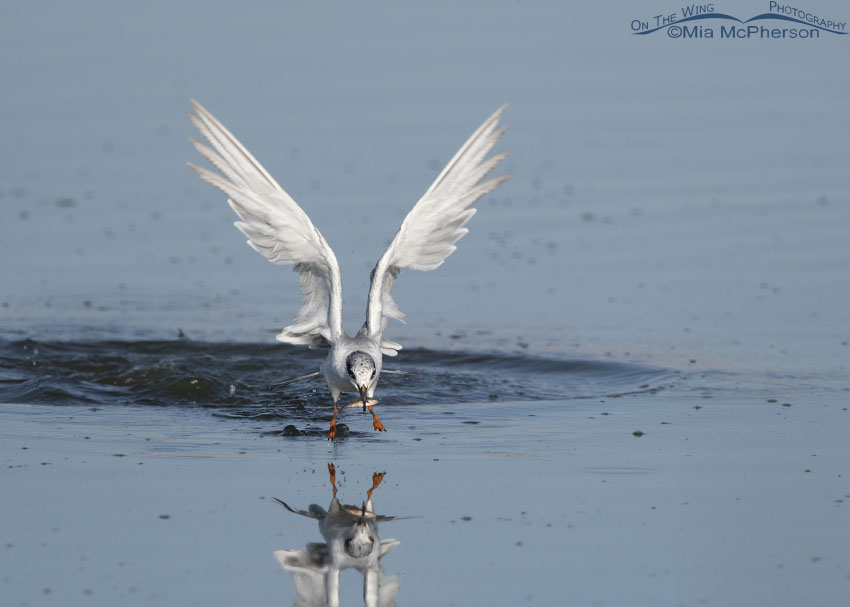 Forster’s Tern after successful dive for prey – Nikon D500, f6.3, 1/3200, ISO 400, Nikkor 500mm VR with 1.4x TC, natural light, not baited
Forster’s Tern after successful dive for prey – Nikon D500, f6.3, 1/3200, ISO 400, Nikkor 500mm VR with 1.4x TC, natural light, not baited
I have had fun photographing Forster’s Terns the last few times I have gone to Bear River Migratory Bird Refuge, they are graceful, beautiful terns and they challenge my skills. They fly fast, they hover and dive erratically and keeping track of them through a long lens is trying but whenever I can get photos of these terns I am always happy. My success rate for these terns is low, I probably toss out 100 images for every one I keep.
Their hunting success rate is much higher though, I would estimate that for every three dives they make they come up with prey twice. This adult Forster’s Tern in nonbreeding plumage came up with a tiny fish after it dove into the water at the end of August.
 Forster’s Tern lifting off from water with prey – Nikon D500, f6.3, 1/3200, ISO 400, Nikkor 500mm VR with 1.4x TC, natural light, not baited
Forster’s Tern lifting off from water with prey – Nikon D500, f6.3, 1/3200, ISO 400, Nikkor 500mm VR with 1.4x TC, natural light, not baited
And it was easily able to lift off and it flew almost directly towards me. The tern swallowed its prey in flight before I lost focus on it because of some vegetation that was between me and the tern.
Forster’s Tern Facts and Information:
- Forster’s Terns are medium sized terns with white underparts and pale gray upperparts, short red legs, thin, orange bills with black tips and a black cap in breeding plumage. They have long, forked tails. In nonbreeding plumage they have a black comma shaped ear patch.
- Forster’s Terns are migratory although it is the only tern found in North America throughout the year.
- During the breeding season their preferred habit includes marshes with lots of open water and islands with vegetation.
- Forster’s Terns eat fish and small arthropods.
- Forster’s Terns lay 1 to 6 eggs which hatch in 23 to 25 days. Both sexes incubate and they are monogamous.
- A group of terns can be called a “ternery” of terns.
- Forster’s Terns can live up to 16 years.
Forster’s Terns are fun to photograph and I enjoy watching them in flight and catching prey. I used to photograph them in Florida during the winter along the shore of the Gulf of Mexico at Fort De Soto County Park. I am thinking a lot about Florida today as Hurricane Irma roars up the coast. My thoughts are with my friends and family there and everyone else who is hunkered down waiting for Irma to go past.
Life is good.
Mia
Click here to see more of my Forster’s Tern photos.


Thank you for the wonderful education you provide each & every day. It is the first thing I do each morning.
I have been watching hurricane Irma much of the afternoon. I am thinking prayerfully of your family and friends.
Beautiful, I hope you captured some again today.
A success rate of one in three is really impressive. Don’t you wish you could nail as many images as they do dinners? And thank you so much for those that you do.
What dynamic images! You might throw away a lot of images to get the ones that are spectacular, but thank you for being there to catch these shots!
As an aside, I think when they swallow (or catch) their prey on the wing, they’re just showing off! I can fly. You can’t! Sucks to be you!
Great photos…interesting info…love the combination.
These photos are wonderful. I’m glad I’m not the only one who finds it hard to keep up with the flying antics of terns. I’ve never seen a Forster’s Tern but keeping up with the Common Terns and Caspian Terns when they are flying & diving is frustrating. Whenever I see one at rest I eagerly snap a photo.
These are stellar images, Mia! Like these birds diving for prey, your persistence pays off handsomely!